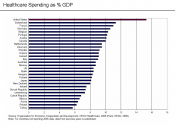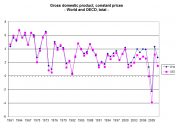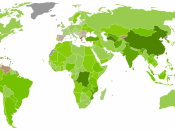This essay will discuss how environmental impacts in different economic regions of the world are changing. It will do this by summarizing evidence provided in the course materials.
Economic factors are being introduced by social scientists as having environmental impacts on the planet. Over the years, man's quest for development has put enormous pressure on nature and the environment. The strategy for rapid development rests on the exploitation of natural resources and the environment, resulting in global warming.
The World Bank (2005) provides data which shows annual average deforestation, CO2 emissions and gross domestic product, or GDP of regions in the world. The GDP of a country is defined as the market value of all final goods and services produced within a country in a given period of time.
It is evident that EMU countries such as Ireland and Spain have a high level of GDP. However, Latin American and Caribbean counties have the highest level of GDP per unit of energy use than any other countries.
These countries include Brazil and Mexico which are the main countries which produce coffee and tobacco products. Because of high levels of consumers and the growing population, these figures are still rising. The World Banks (2005) figures show that in 1990 the word GDP was 3.9 but in 2002 it had risen to 4.6.
Nevertheless, high income countries such as Japan and North America have the highest levels of CO2 emissions closely followed by Eastern European and central Asian countries. The high CO2 figures in these countries may indicate the level of population and size of the country, as high income countries usually are bigger and more populated and therefore more vehicles to produce CO2 emissions. In comparison, lower income countries like South Asia and Sub-Saharan Africa have a low level...


